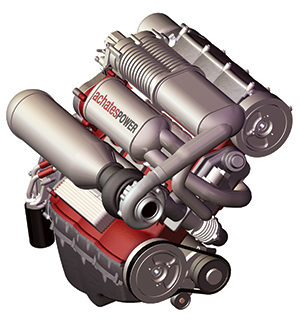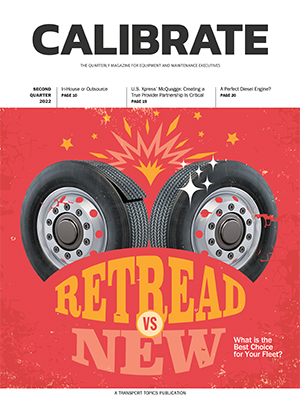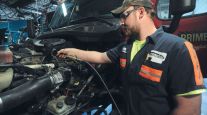Will the Diesel Engine Ever Be Perfected?
[Find the latest in equipment & maintenance: Explore this quarter's issue of Calibrate]
The California Air Resources Board has approved for 2027 what the Engine Manufacturers Association refers to as “sweeping new regulations affecting heavy-duty trucks sold in the state.”
The regs include a 90% reduction in NOx, half the particulate, and especially the ability to do this under low-load conditions. Crawling conditions pertain all too often on California freeways and are only predicted to get worse — hence the part of the rule relating to low load.
New technologies like skip-firing — as well as any number of potential after-treatment modification like extra selective catalytic reduction (SCR) catalysts located closer to the turbo — could, it is likely, meet the requirements. But the Engine Manufacturers Association is concerned about the complexity and high cost of such equipment, not to mention the research needed to develop it all into a marketable package.
The truck diesel as presently configured, as much as I admire and love the technology, is obviously an outmoded design. Wedded to Rudolf Diesel’s 1893 patent and other aspects of current practice, and faced with the need to advance engine design conservatively so fleets will enjoy reliability, the industry has been sticking to its guns, and is now confronted with the need to build a fearfully complex and expensive engine designed along traditional lines and try to sell it.

Baxter
The bottom line here is that there are possibilities with architecture and combustion that the industry is ignoring.
Achates Power has developed an opposed-piston, two-stroke diesel, previously described in this space, originally with the intent to save fuel. Achates CEO and President Dave Crompton and Executive Vice President Larry Fromm argue that Achates is poised to meet these stringent standards with inexpensive features incorporated in their design, while also meeting standards requiring lower fuel consumption.
The real news here is that Achates’ combustion is much cleaner than combustion in standard, four-stroke engines. The Achates can use high levels of exhaust gas recirculation (EGR) to kill NOx (and speed warmup) till the SCR system gets hot enough to work, but without generating the heavy amounts of particulate standard diesels produce under such conditions. Achates’ opposed piston design with dual fuel injectors sends the fuel in from the sides of the cylinder toward the center, not toward the walls of the chamber in the piston. Also, its opposed pistons have combustion chambers of different sizes. This drives air vertically through the sprays and generates what Fromm refers to as “high-tumble combustion,” which is so much better at mixing fuel and air that this high level of EGR becomes practical.
Add to this the fascinating work of Charles Mueller and his team at Sandia National Laboratories in developing their intriguing Ducted Fuel Injection concept, also previously described in this space. Sending the fuel sprays through a small duct prior to their ignition in the combustion chamber creates much better fuel/air mixing and a consequent significant reduction in particulate, with the attendant opportunity to make higher levels of NOx-killing EGR practical. Mueller says several manufacturers are taking a look at the concept. But, none seems to be discussing the use of it to make those allegedly draconian standards reachable.

Engines like the A48 from Achates Power, have been developed to meet the new challenges for diesel consumption. (Achates Power Inc.)
Advanced combustion experts have been dreaming for more than 20 years of finding ways to clean up diesel combustion by increasing the time the fuel and air have to mix without losing control of when and how fast combustion occurs. Diesels use the injection system to directly determine when and how fast the fuel burns, as you may know. The fuel is kept out of the combustion chamber until the engine is just about ready to expand the charge and enter the power stroke. It’s then injected over a period of time (a number of degrees of crankshaft rotation) to keep it from releasing energy too quickly. This concept is in Diesel’s patent.
A landmark 2003 SAE paper by Kathi Epping et al., “The Potential of HCCI Combustion for High Efficiency and Low Emissions,” discussed the potential of a concept that would solve many of the diesel’s problems, especially the tendency to create particulate. Homogeneous charge compression ignition (HCCI) refers to using compression ignition, but combining it with pre-mixing — a concept more like what is used in gasoline engines where all the fuel goes in well before the burning starts, and has time to mix with the air before ignition occurs. But HCCI is very difficult to control, and subject to pre-ignition, especially with diesel fuel.

More Q2 Calibrate
►Tire Choices Provide Pros, Cons for Fleet Maintenance Managers
►Send Out Your Maintenance Labor, or Keep It in the Fleet Shop?
►Five Questions: Greg McQuagge, U.S. Xpress
►Freeze: Winning the Hearts and Minds
►TMC Corner: Warming Up to Smart Trailer Tech for Cold Chain Logistics
►Baxter: Will the Diesel Engine Ever Be Perfected?
Explore the Issue!
However, burning fuel this way is more efficient. Engineers call this “cool flame combustion.” The flame is virtually soot free and blue in color rather than yellow as diesel flames are, which keeps more of the heat in the hot gases instead of throwing it into the cooling system. HCCI combustion also tends to be smoother, which reduces the period of “rapid heat release” as engineers call it — the distinctive diesel knock. This characteristic of present diesels makes NOx and, like particulate, tends to transfer heat out of the hot gases and into the cooling system, killing efficiency. HCCI combustion can occur faster, yet more smoothly, optimizing efficiency and making the engine quieter.
In fact, HCCI is nothing new, and there are several examples of successful work in this area from years ago. One is the M engine, which took the form of the multifuel diesel the Army used in Vietnam, which I had much experience with as a technician and driver. The engine was smoother than standard truck diesels and operated from 1,400-2,600 rpm in tractors that could pull up to 72,000 pounds. It favored diesel fuel, but could also run on jet fuel and low-octane military gasoline. It did not work like a regular diesel, but provided time for fuel/air mixing. All the fuel was introduced some time before combustion even began and violently swirling air evaporated the fuel off the surface of a small, spherical chamber in the piston during combustion. While the engines in military trim smoked, with modern turbocharging and charge air cooling the concept would likely deliver particulate-free performance because of the different way the fuel was evaporated and mixed.
The concept was developed at MAN, the German diesel manufacturer that provides some of the basics of the International A-26 engine, by an engineer named Siegfried Meurer.
There is also a small venture called Advance Diesel Concepts that has a pre-mixed combustion system that is closer to a standard diesel than the multifuel diesel, burning the fuel while it is suspended in air. It combines some of the ideas of a German-American engineer named Max Fiedler with much later work and some fresh ideas. Fiedler argued for a concept like HCCI in the early 1940s, and actually corresponded with Meurer.
Want more news? Listen to today's daily briefing above or go here for more info
ADC’s design was successfully modeled on computers at the University of Wisconsin. This combustion system would work in standard four-stroke diesels, but injects all the fuel prior to burning, a basic key to particulate reduction even with high levels of EGR. Pre-ignition is prevented by discarding some assumptions made in designing today’s diesels. The level of particulate at moderate loads meets the projected future standard without a DPF.
There is much evidence that diesels can be much cleaner than they are today, provided some serious basic research were done and the designers would be willing to depart more radically from today’s practices than they are at present.
The diesel won’t be around forever. Unless our industry begins to break away more effectively from its present ways of thinking about combustion and designing engines, it will be extinct before it ever reaches its full potential as an efficient and clean power plant. The industry needs to get serious about the possibility of adapting Achates architecture, and exploring advanced combustion.
To paraphrase a line from Hamlet, “There are more things in heaven and earth, diesel industry, than are dreamt of in thy narrow perspective.”




